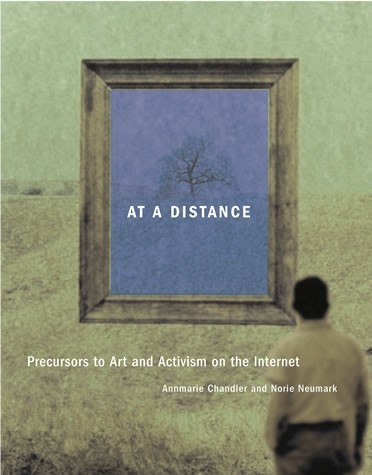Susan Kozel: Closer: Performance, Technologies, Phenomenology (2007)
Filed under book | Tags: · body, dance, human-computer interaction, performance, phenomenology, philosophy, technology, telematics, wearable computing

“In Closer, Susan Kozel draws on live performance practice, digital technologies, and the philosophical approach of phenomenology. Trained in dance and philosophy, Kozel places the human body at the center of explorations of interactive interfaces, responsive systems, and affective computing, asking what can be discovered as we become closer to our computers—as they become extensions of our ways of thinking, moving, and touching.
Performance, Kozel argues, can act as a catalyst for understanding wider social and cultural uses of digital technology. Taking this one step further, performative acts of sharing the body through our digital devices foster a collaborative construction of new physical states, levels of conscious awareness, and even ethics. We reencounter ourselves and others through our interactive computer systems. What we need now are conceptual and methodological frameworks to reflect this.
Kozel offers a timely reworking of the phenomenology of French philosopher Maurice Merleau-Ponty. This method, based on a respect for lived experience, begins by listening to the senses and noting insights that arrive in the midst of dance, or quite simply in the midst of life. The combination of performance and phenomenology offered by Closer yields entwinements between experience and reflection that shed light on, problematize, or restructure scholarly approaches to human bodies using digital technologies.
After outlining her approach and methodology and clarifying the key concepts of performance, technologies, and virtuality, Kozel applies phenomenological method to the experience of designing and performing in a range of computational systems: telematics, motion capture, responsive architectures, and wearable computing.
The transformative potential of the alchemy between bodies and technologies is the foundation of Closer. With careful design, future generations of responsive systems and mobile devices can expand our social, physical, and emotional exchanges.”
Publisher MIT Press, 2007
Designer: Rebeca Méndez
ISBN 0262113104, 9780262113106
355 pages
PDF (updated 2016-5-4)
Comments (2)Jacques Ellul: The Technological Bluff (1990)
Filed under book | Tags: · critique, critique of technology, entropy, genetics, radio, technocracy, technological society, technology, telematics

This poignant critique of modern society shows how we have mistakenly allowed technology to fool us into thinking about all of our problems in terms of technical progress. This technological bluff, Ellul claims, deprives us of active adaptation to and criticism of technical growth.
The author argues that “an easily distracted consumer society is caught up in a rapidly developing, uncontrollable technological system. … Everyproblem generates a technological solution; computers breed ever larger, morefragile, and vulnerable systems. But the solutions raise more and greater problems than they solve. … Responsibility, contemplation, civility, and spirituality suffer.” (Choice)
Published by Wm. B. Eerdmans Publishing, 1990
ISBN 080280960X, 9780802809605
436 pages
Key terms:
Minitel, telematics, Le Monde, Third World, technopolis, genetic engineering, independent local radio, technocrats, videotex, microcomputers, entropy, Testart, Jacques Ellul, gross national product, Nomenklatura, artificial intelligence, University of Bordeaux, technostructure, vitro fertilization, Paris
PDF (updated on 2012-8-11)
Comment (1)Annmarie Chandler, Norie Neumark (eds.): At a Distance: Precursors to Art and Activism on the Internet (2005)
Filed under book | Tags: · 1970s, 1980s, activism, art history, experimental art, fluxus, mail art, media art, network art, network culture, networks, new media, radio art, telematics

“Networked collaborations of artists did not begin on the Internet. In this multidisciplinary look at the practice of art that takes place across a distance—geographical, temporal, or emotional—theorists and practitioners examine the ways that art, activism, and media fundamentally reconfigured each other in experimental networked projects of the 1970s and 1980s. By providing a context for this work—showing that it was shaped by varying mixes of social relations, cultural strategies, and political and aesthetic concerns—At a Distance effectively refutes the widely accepted idea that networked art is technologically determined. Doing so, it provides the historical grounding needed for a more complete understanding of today’s practices of Internet art and activism and suggests the possibilities inherent in networked practice.
At a Distance traces the history and theory of such experimental art projects as Mail Art, sound and radio art, telematic art, assemblings, and Fluxus. Although the projects differed, a conceptual questioning of the “art object,” combined with a political undermining of dominant art institutional practices, animated most distance art. After a section that sets this work in historical and critical perspective, the book presents artists and others involved in this art ‘re-viewing’ their work—including experiments in ‘mini-FM’, telerobotics, networked psychoanalysis, and interactive book construction. Finally, the book recasts the history of networks from the perspectives of politics, aesthetics, economics, and cross-cultural analysis.”
Publisher MIT Press, 2005
ISBN 0262033283, 9780262033282
xiv+486 pages
Reviews: Publishers Weekly (2005), Vincent Bonin (2005), Graham Meikle (Scan, 2006), Paolo Gerbaudo (Culture Machine, 2006), Joel Slayton (Art Book, 2006), Karrie Karahalios (New Media & Society, 2006), Jennifer Way (RCCS, 2008, with responses from editors).
PDF (updated on 2019-11-22)
Comments (3)
